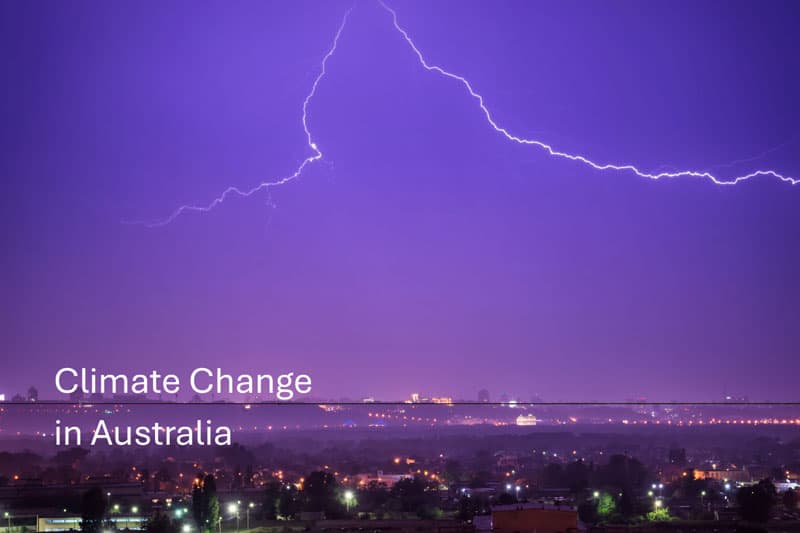An Australia is experiencing multiple climate changes throughout the nation such as noticing high temperature from last few years. That means more high temperature days with unpredictable weather changes. Many forests report a bushfire due to severe wind and high temperature. It is also affecting a sea level and disturbing the marine eco system. Due to the increase in pollution and waste effects, wildlife creatures and aqua creatures are in danger to leave longer.
Due to the geographic location, Australia can take advantages of natural resources to align with the global sustainability goals. It can be possible to rely on natural sources such as wind, tidal, hydrothermal and other renewable sources. Businesses should address climate risks and adopt better sustainable solution to meet Net Zero goal.
Impact of climate change in Australia
Rising Sea levels
- Australian’s coastline is stretching over 25000Km. Sea level is rising due to the flooding, high tides, coastal erosion etc.
- It is also affecting to the infrastructure and agricultural lands.
Temperature Hike
- Australia is facing risen temperature year by year. According to the Bureau of Meteorology and CSIRO, average temperatures have risen by 1.5 degrees compared to 1910. Australian are experiencing more heatwaves and sunny days then previous.
- It is affecting the people/s health by increasing the risk of sunburn, cancer, heat stress etc.
Extreme Weather
- Due to the climate change, Australia has reported more frequent cyclone, extreme waves, hailstorms, severe droughts, floods, earthquakes and bushfires.
- It is impacting to the crops, animal and human lives. Also, affecting nation’s economy and growth.
Wildlife and Marine Life
- Due to the climate change, ocean water temperature is rising up compared to the 1910.
- Marine ecosystem is affecting due to the heatwaves, severe tides and pollution. Many species are in risk and about to disappear due to the affected ecosystem.
Effects of climate change in ESG
Environmental (E)
- Destructed ecosystems are decreasing biodiversity.
- Increasing the ocean acidification, pollution and minerals. That affects the marine industries, infrastructure and fishing industries.
- Farming and agriculture industries are affected by the climate change. Making them harder to prevent crops from the affected by nature. It is increasing the cost of living and economic development.
Social (S)
- Due to the draught and bushfires, animals and humans have less sources of food and water.
- Also, facing a health issue such as cancer, heat burn, stress and mental illness.
- Number of deaths related to heatwaves are increasing.
Governance (G)
- According to the climate change Act 2022, Australian government has pressure to achieve Net Zero emission by 2050.
- Government is pushing organisation to take a step towards better sustainability by forcing various policies, frameworks, financial disclosure rules to align with the international sustainability standards board (ISSB) and Australian securities and investments commission (ASIC).
What is climate risk assessment in organisation?
It is the process of identifying, evaluating and developing strategies related to climate change and potential impact.
- Step 1: Identify the risk – Risk assessment process starts with the research and identify the climate risk associated with the organisation.
- Step 2: Evaluation – At this stage, organisation evaluate the climate change and affecting areas such as supply chain, operational team and finance.
- Step 3: Develop Strategies – Organisation check the current data, risks and available options to adopt sustainability and prepare strategies to follow the Net Zero path and put their affords to the better lifestyle.
Climate risk associated with the Organisation
- Physical Risks
- Direct climate risk to the organisation such as severe wind, floods, cyclones, bushfires and heatwaves.
- Long-term climate risks such as soil erosion, sea level rise and increment of temperature.
- Transition risk:
- Australian government released some policies and regulations to stay below carbon emissions. Due to Net Zero and other policies, organisations are now in pressure to shift their supply chain and use of products to meet the sustainable growth.
- Demand is increasing for the biodegradable products and sustainable solutions.
- Innovation and research are considered as transition risks as technology disruption.
Liability Risks
- Organisations are in liability risks to get the fines, notice and strict action due to not following the climate change policy.
- Stakeholders can maintain the public trust and keep their reputation unharmed.
Why Climate Risk Assessment Matters?
- To ensure company follows ESG frameworks and Task force on climate-related Financial Disclosures (TCFD) and present the report compliance within the standards.
- Risk assessment helps the organisations to reduce 70-80% carbon emission reduction by 2035 and meet Net Zero by 2050.
- The climate risk assessment process can strengthen the company reputation and stakeholder public trust.
- It also helps the company to stay updated with the climate change data, operational process and trend of the climate change due to their actions.
How KubeNest can manage your Climate Risk Assessment data?
All-in-One GHG emission tool
- KubeNest is all-in-one data management software, collect and transform your data into a custom analytic report that you can share with the stakeholders and investors to maintain the transparency, trust and accuracy. Collect scope 1, scope 2 and scope 3 data across the operational team.
- Custom Analytics Dashboards – Get access to the custom-made analytics report with the various filter options. Track emissions trends, suppliers and scenarios.
- Data Accuracy – Reduce the manual data entry and enhance reliable accurate data
- Compliance with the standards – Ready to audit GHG Scope 3 emissions data report which is compliance with the international standards, frameworks and regulations.



